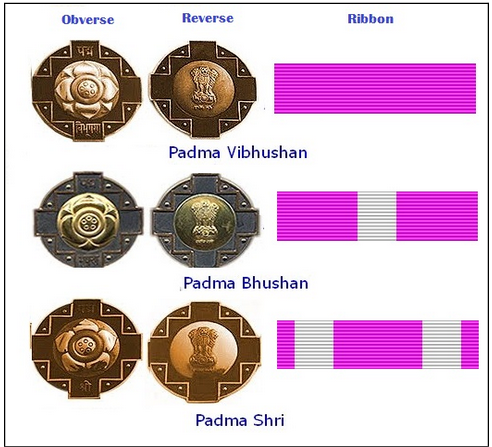News Excerpt:
On April 22nd, President conferred the esteemed Padma awards to several personalities including former Vice President M. Venkaiah Naidu, Sulabh International founder Bindeshwar Pathak, actor Mithun Chakraborty, and numerous other prominent figures. The ceremonial event took place at the Rashtrapati Bhavan.
More About the News:
- The Padma Awards, among India's most esteemed civilian honors, are annually announced on the eve of Republic Day. These awards, categorized into Padma Vibhushan, Padma Bhushan, and Padma Shri, aim to recognize outstanding contributions across various fields with a focus on public service.
- Established in 1954, the Padma Awards replaced the earlier civilian honors.
- Bharat Ratna, the highest civilian award, operates separately from the Padma Awards, being recommended directly by the Prime Minister to the President, with a maximum of three recipients per year.
Features:
- Padma Vibhushan: The decoration is primarily circular, with a geometric pattern overlaid.The geometric pattern consists of a square, with rectangles on each side breaking the circular design. Knobs are embossed at the outer angles of the pattern. The obverse features an embossed lotus flower with "Padma" above and "Vibhushan" below in Hindi. The reverse showcases the State Emblem and motto in Hindi. The decoration is toned bronze.
- Padma Bhushan: This award is similar to Vibhushan with the only difference being the word "Bhushan" instead of "Vibhushan" below the lotus flower on the obverse. The inscription, geometric pattern, and border on both sides are of burnished bronze, and all embossing is of standard gold.
- Padma Shri: This decoration also shares the same dimensions and basic design as the Vibhushan and Bhushan. The key difference is that, it features knots at the outer angles of the pattern. The obverse has a lotus flower with "Padma" above and "Shri" below in Hindi. The reverse displays the State Emblem and motto in Hindi.

Selection Criteria:
- Recommendations are sought annually from May 1st to September 15th from various governmental bodies, including state and union territory governments, ministries/departments of the Government of India, as well as previous awardees of Bharat Ratna and Padma Vibhushan, and Institutes of Excellence.
- Recommendations are also accepted from other sources such as central/state ministers, chief ministers/governors of states, members of parliament, and private individuals or organizations.
- The Padma Awards Committee, formed by the Prime Minister each year and headed by the Cabinet Secretary Along with Principal Secretary to Prime Minister, Home Secretary, Secretary to the President, along with other eminent members, evaluates these recommendations.
- There are no rigid criteria. The award is not solely based on long service or excellence in a particular field but on a combination of excellence and public service.
- The recommendations approved by the Padma Awards Committee are then submitted to the Prime Minister and the President for final approval.
Before the institution of the Padma Awards Indian awards:
- Knight Commander of the Order of the Star of India (KCSI): Established in 1861 by the British East India Company, this honor was given to recognize distinguished service to the British Empire in India.
- Companion of the Order of the Indian Empire (CIE): Also established in 1861, this was another British colonial award given for service in India.
- Knight Commander of the Order of the Indian Empire (KCIE): Similar to the KCSI, this honor recognized outstanding service to the British Empire in India.
- Rai Sahib and Khan Bahadur: These titles were conferred by the British Raj in India to recognize service and loyalty. Rai Sahib was typically given to Indian civilians, while Khan Bahadur was often bestowed upon military personnel and those in administrative positions.
- Kaisar-i-Hind Medal: Instituted in 1900 by Queen Victoria, this medal was awarded to both men and women for public service in India and the British Empire.
- Kaiser-i-Hind Gold Medal: An upgraded version of the Kaisar-i-Hind Medal, this was awarded for exceptional and distinguished service to the British Raj in India.
- Indian Police Medal: Established in 1932, this medal recognized acts of conspicuous gallantry or distinguished service by officers of the Indian Police.
- Indian Order of Merit: Instituted in 1837, it was one of the highest awards for gallantry and meritorious service in the British Indian Army until it was replaced by the Param Vir Chakra, Maha Vir Chakra, and Vir Chakra after independence.
- Indian Distinguished Service Medal: Established in 1907, this medal recognized meritorious service by Indian commissioned officers in the British Indian Army.
Conclusion:
The awards are conferred during a ceremony typically held in March or April, where recipients receive a certificate and a medallion from the President. While not conferring a title, the Padma Awards recognize exceptional service and achievement across diverse domains, contributing to the nation's welfare and development.


